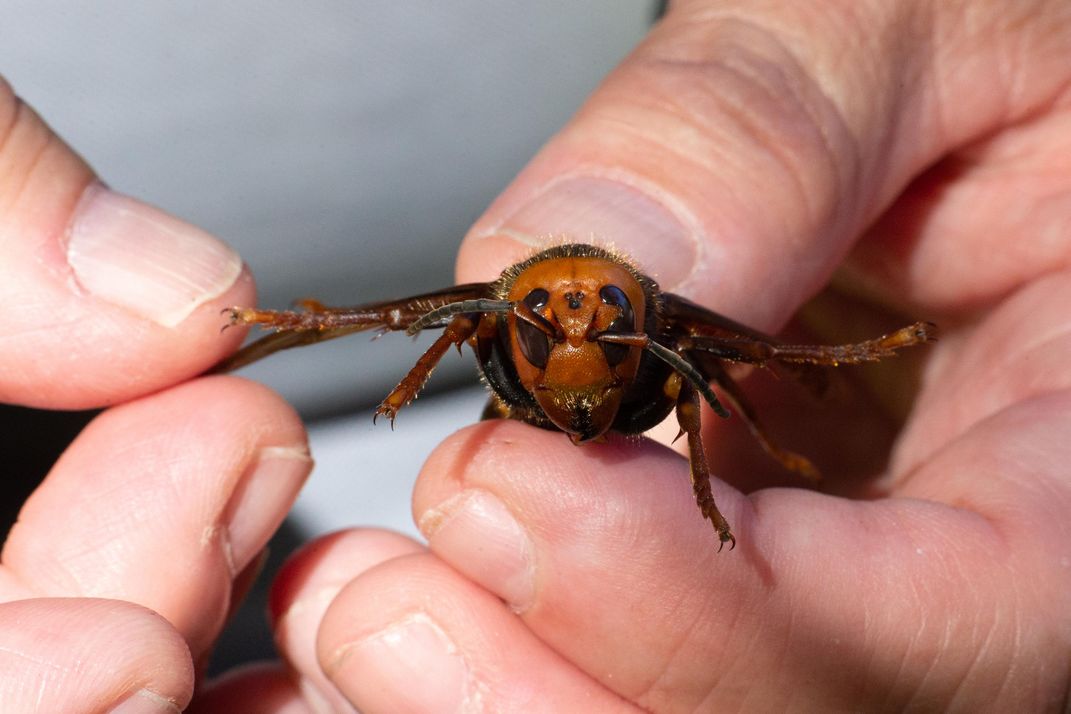First Live ‘Murder Hornet’ Captured in the U.S.
Scientists aim to eradicate Asian giant hornet nests in the next few weeks so that the insects do not establish a population on the West Coast
/https://tf-cmsv2-smithsonianmag-media.s3.amazonaws.com/filer/0d/d7/0dd7d0ea-642a-4add-96ac-11b779ef7147/ap_20276749848362.jpg)
When residents of northern Washington state noticed Asian giant hornets visiting a paper wasp nest on the eaves of their house, they took quick action. They trapped and photographed two of the so-called ‘murder hornets’ and contacted the Washington State Department of Agriculture, WSDA entomologist Sven Spichiger told reporters in a press conference on October 2.
Later, entomologist Chris Looney visited the property, and another hornet stopped by. Looney captured the hornet in a net, making it the first live Asian giant hornet captured in the United States.
Live captures provide an opportunity that sightings and discovering dead insects do not. The entomologists attempted to glue a tracking device to the live hornet’s back so that they could follow it back to its nest. The W.S.D.A. hopes to eradicate hornet nests before the species establishes itself on the West Coast, where it could find ample habitat, according to new research published in the Proceedings of the National Academy of Sciences.
But when the team tried to glue the tracker to the insect’s back, only was the hornet uncooperative, but the glue didn’t dry fast enough, and the tracking device fell off. By the time the team tied the device to the insect with a piece of thread, one of its wings had touched the wet glue, leaving the hornet unable to fly, Spichiger said.
The WSDA entomologists plan to use what they learned in the first attempt the next time they have an opportunity to track a live hornet. They have set up sentinel hives, which are beehives with a small grate on top that allows honeybees to pass but catches giant hornets, in the area. They hope to catch another hornet in the next few weeks.
"We have peppered the area with 30 live traps," Spichiger said in the press conference, David Williams reports for CNN. "We're probably going to snag one if not more of them, and we'll be able to give this another try."

Asian giant hornets usually grow to about two inches long, have large orange heads with black oval-shaped eyes, and build their nests underground, according to the WSDA website. The “murder hornet” moniker arose when the New York Times’ Mike Baker reported on the first U.S. sightings earlier this year. While the hornets pose little danger to humans or pets unless provoked, in late October they are at their most destructive.
“Asian giant hornets this time of year start going into what we call the slaughter phase,” Spichiger said, as Christine Clarridge reports for the Seattle Times. “They will visit apiaries, basically mark a hive, attack it in force, removing every bee from the hive, decapitating them, killing all of the workers and then spending the next few days harvesting the brood and the pupae out of the hive as a food source.”
The WSDA has set up a specific phone line for beekeepers to report active attacks against their hives. Spichiger also emphasized during the press conference that the hornets’ pose a threat to native pollinators, like the paper wasps on the eaves of the house where the first live hornet was captured.
If Washington is unable to stem the spread of new nests, giant hornets will find a lot of suitable habitat in the Pacific Northwest where they could spread in the next 20 years, Curtis Segarra reports for Science News. The new research published in the Proceedings of the National Academy of Sciences shows that the mild, rainy climate is perfect for Asian giant hornets.
“There is a considerable amount of suitable habitat along the West Coast and our dispersal simulations of how quickly the invasion might spread were surprising to us,” says Washington State University entomologist David Crowder to Science News.
Similar habitat can be found on the East Coast as well as Africa, Europe, Australia and South America, where giant hornets could make a home if humans inadvertently carry them there, according to a statement.
While there have been hundreds of Asian giant hornets found in North America, only 15 confirmed sightings have been recorded in the United States. Six of those came from the past few weeks: three at the paper wasp nest, one photographed by a doorstep camera, one caught in a streetlamp, and one found on a front porch and discarded. The WSDA suspects all six came from the same nest.
“The actual number of colonies out there is so small that if we can find a few of those colonies, we might be able to completely eradicate them,” says University of California, Riverside entomologist Douglas Yanega to Science News. “It doesn’t look like the kind of situation that’s capable of exploding on us, and it certainly hasn’t so far.”